Carbon Intensity Indicator (CII) – Remain compliant and cut costs
As the regulatory framework for ship emissions takes effect, the financial incentives to comply with regulations become stronger. Since January 1, 2023, ship operators must report on their attained Energy Efficiency Existing Ship Index (EEXI) if the vessel is at or above 400 GT. Additionally, reporting the Carbon Intensity Indicator (CII) has become mandatory for all ships above 5,000 GT. The regulators then use both scores to determine whether a ship meets the required minimum energy efficiency standard.
How can ships improve their energy efficiency?
Each vessel receives an energy efficiency rating from A to E (with A being the best) according to their Carbon Intensity Indicator. From then on, the shipping operators record their vessels' performance level in the Ship Energy Efficiency Management Plan (SEEMP). In this plan, the ship operator commits to an annual review of the energy efficiency performance and its steady improvement. Measures like speed optimization, the use of alternative fuels, or the installation of renewable auxiliary power can improve the CII.
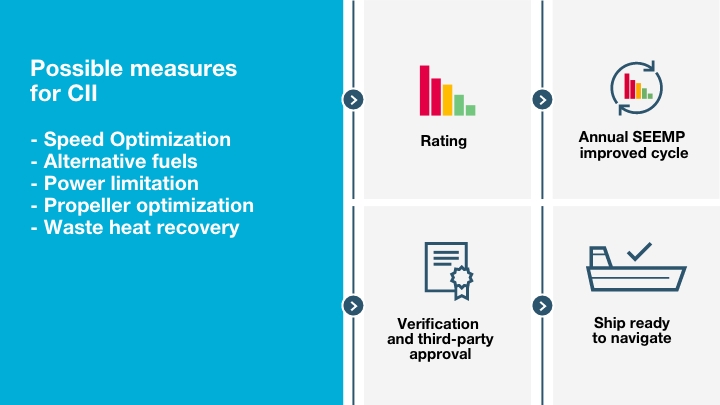
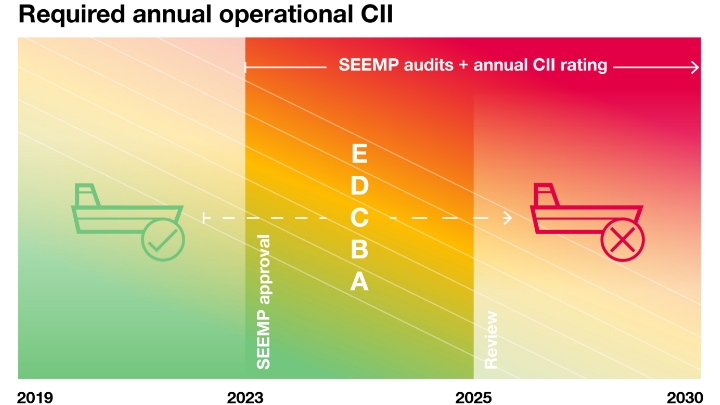
What does CII mean for compliance?
The CII measures how efficiently a ship transports goods or passengers. This index is given in grams of CO2 emitted per cargo-carrying capacity and nautical mile. The CII is one of the most important measures for energy efficiency in maritime operations. Its thresholds become more stringent over time until 2030.
In practice, this means that a vessel with the rating of A might decrease its rating over time, becoming a ‘B’ rated vessel or worse. If the vessel is evaluated with ‘D’ or ‘E’, the sip operator needs to submit a corrective plan, to show how the required index (C or above) would be achieved. This process applies to all ships above 5,000 GT.
It´s not a contradiction to comply with regulations and to save fuel & budget.
Explore
We as original manufacturer can give you the maximum compliance and fuel saving solutions:
Propeller solutions
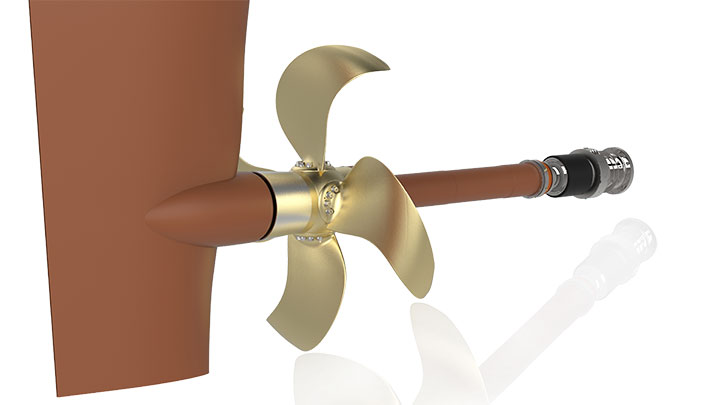
CP Propeller Upgrade
All engine configurations with MAN Alpha CPP and remote control system
Upgrade your CP propeller with the latest technology and hydrodynamic know-how. A CP propeller optimization provides great fuel-saving, allowing your vessel to meet stricter emission levels and CII requirements. This upgrade also potentially improves your energy class while optimizing your operational economy, providing a short return on investment.
Learn moreMAN EcoOptimizer
All engine configurations with MAN Alpha CPP and remote control system
The power required for propelling the ship and the corresponding SFOC of the main engine determines its total fuel oil consumption. Comparing the runs of the optimum propeller and engine curves will reveal that they do not coincide. One curve is optimal for the propeller and another one for the engine. MAN EcoOptimizer harmonizes both curves for optimal energy efficiency.
Turbocharger solutions
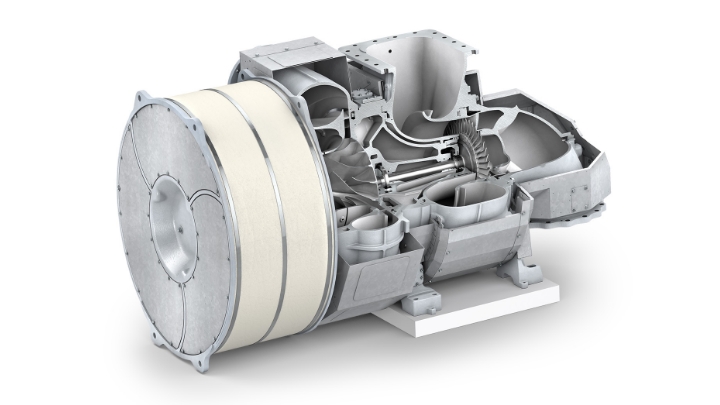
Turbocharger Retrofit
The existing turbocharger of any manufacturer will be replaced by a state of the art MAN turbocharger. Available for 2-stroke and 4-stroke engines on marine vessels and power plants. A turbocharger retrofit can give benefits including lower fuel consumption (especially when combined with other products), reduced exhaust gas temperature, optimized matching along with the load profile of the engine and extended overhaul and a new warranty.
Learn more2-stroke solutions
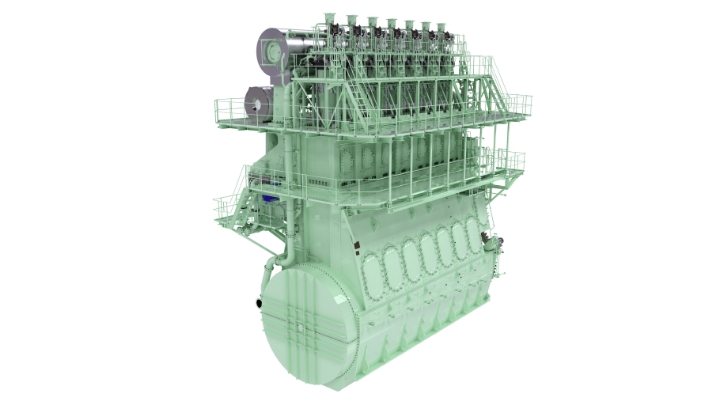
MC/MC-C retrofit solutions
MAN EcoCam
The MAN EcoCam is a low-cost, simple fuel saving product. This low-load optimized virtual cam gives you lower emissions and instant fuel savings between 10% and 60% load. The MAN EcoCam enables efficient slow steaming with operational flexibility for mechanical engines and is available for engines with a wide exhaust camshaft.
MAN EcoNozzle
Fuel savings with the MAN EcoNozzle, the latest addition to the new MAN Eco family designed to provide fuel savings in the entire load range! With this new concept fitted, your engine will have state-of–the-art combustion control.
PMI VIT
PMI VIT system is used for mechanically controlled MAN B&W two-stroke engines and ensures the optimal cylinder pressure by controlling fuel-injection timing via an electronic actuator on the VIT (variable injection timing) rack.
Flexible Turbocharger Cut-Out
The Flexible Turbocharger Cut-Out (TCCO) gives operators the option to disable one of the turbochargers for slow steaming operation. This improves the performance of the remaining turbochargers, thus reducing SFOC.
ME/ME-B/ME-C retrofit solutions
MAN EcoTorque
Governor control to improve cylinder liner condition and lower fuel consumption. MAN EcoTorque improves the cylinder liner condition and fuel consumption by stabilizing the fuel index. This means that short-term external influences will not put excess strain on the engine, and the fuel index will remain steady.
Learn more
PMI Adaptive Cylinder Control
With PMI Adaptive Cylinder Control, MAN Energy Solutions is taking engine tuning to the next level. Using a new, patented algorithm, closed loop control ensures that each individual cylinder always operates at its optimal cylinder pressure. This gives you the best engine performance and lowest possible fuel consumption at all times.
Learn more
Flexible Turbocharger Cut-Out
The Flexible Turbocharger Cut-Out (TCCO) gives operators the option to disable one of the turbochargers for slow steaming operation. This improves the performance of the remaining turbochargers, thus reducing SFOC
PMI Auto-tuning
PMI Auto-tuning is used for electronically controlled MAN B&W two-stroke engines. This PMI system configuration ensures the optimal cylinder pressure by adjusting the fuel-injection timing and the opening of the exhaust valve.
Dual-Fuel Conversion
A dual-fuel conversion is one of the most effective ways to drive greater efficiency, profitability, and especially CII compliance. Reliability, greater efficiency and compliance with new environmental legislation are just some of the benefits our advanced retrofit solutions provide
Learn moreSpare Part Solutions
Maintenance kits
Correct use of Maintenance Kits assists in reducing fuel and lube oil consumption and ensures optimal energy utilization for propulsion or power generation. Continuous and preventive maintenance of engine components are absolutely key in supporting and maintaining an optimal CII rating.
Learn more
Cement-coated piston ring
OEM piston rings are a critical part of your engine and play an important role in maintaining the performance of surrounding components, including emissions, fuel oil consumption and impacting your CII rating..
Learn more
MXPSS
By using the Docking Package Service Solution, you will always get the latest design, most optimized spare parts and thus optimal engine operation, cost savings and emission optimization. Thereby supporting and maintaining an optimal CII rating.
4-stroke solutions
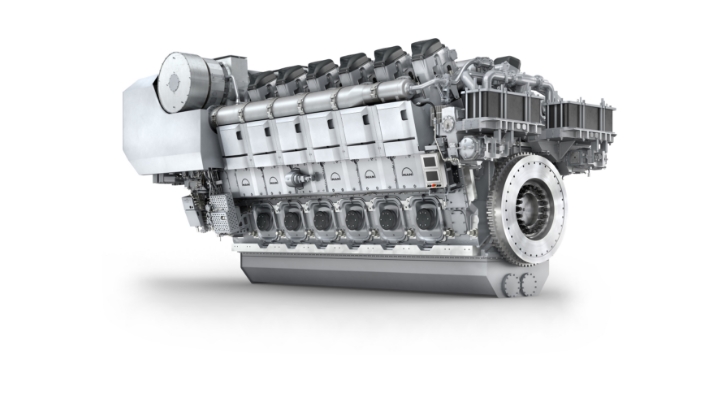
Roadmap Solutions
Lifecycle update (LCU)
The retrofit solution that allows ship owners and operators to renew their MAN 48/60 engines and upgrade them to new MAN 51/60 engines. It includes the replacement of many components as well as upgrades to meet the latest regulations. It's a cost-effective solution to extend your engines' life, improving the safety, performance, and reliability. In addition, it reduces fuel consumption and maintenance costs, allowing for greater efficiency and cost savings.
Learn more
Dual Fuel Conversion
This retrofit delivers complete dual fuel conversion packages with upgraded turbochargers. A customized adaption of gas related plant equipment, engine control and safety installations allows reducing the carbon footprint in line with international and local regulations. Nitrogen oxides (NOx) are also low thanks to an optimized combustion in gas mode.
Learn moreRetrofit Solutions
AdaptiVIT
The AdaptiVIT system uses combustion parameters to determine the injection timing. This guarantees the most efficient combustion process fully complying with the specified emission regulations. Permanent cylinder pressure measurement is the basic parameter of the AdaptiVIT system. Injection timing is permanently closed-loop controlled by the stand-alone system AdaptiVIT.
Engine Part Load Optimization (EPLO)
This retrofit aims to improve the efficiency between 50% and 65% maximum continuous rating (MCR) with a modification of the SaCoS control system. This technology uses the features of the pneumatic variable injection timing (VIT), and no scope of supply is required with this is installed. A new emission test was carried out and approved: the retrofitted engine will belong to a different engine group, and the new technical file is included in the offer for each engine variant.
Bio / Synthetic Fuel Upgrade
This solution enables the engine to run safely and efficiently with a non-petroleum derived fuel without replacing the main components of the engine. This permits to reduce the carbon footprint helping with international and regional emission regulations. A fuel analysis must be provided to build the best customized solution and ensure reliable running of the engine
Spare Parts Solutions
Updated Design Spares
Provides safety window when changing to low sulphur fuels. Lower Specific Fuel Oil Consumption (SFOC) and Specific Lubrication Oil Consumption (SLOC).
Maintenance Kits
Correct use of Maintenance Kits assists in reducing fuel and lube oil consumption and ensures optimal energy utilization for propulsion or power generation. Continuous and preventive maintenance of engine components are absolutely key in supporting and maintaining an optimal CII rating.
Overhaul Packages
By using overhaul packages, you will always get the latest design, most optimized spare parts and thus optimal engine operation, cost savings and emission optimization. Thereby supporting and maintaining an optimal CII rating
MK3 pump
The MK3 (Mark 3) Pump is an injection pump with a sealing ring around the plunger to avoid the lacquering effect. It is easy to retrofit on existing engines, best retrofit opportunity is during a scheduled pump maintenance interval. This improved conventional fuel injection system is compatible for MAN engine families 23/30, 32/40CD, 48/60 B, 48/60 TS, 51/60 and 58/64 CD. Whereof 48/60A is still being under development.
Discover the success stories of our clients
Performance Measurement Indicator
Chevron retrofitted five of its vessels with an MAN Energy Solutions PMI system and allowed MAN Energy Solutions to review subsequent fuel consumption data. The result: 22 tonnes of fuel per day saved.
Get in touch now to start your path to CII compliance
Compliance requires effort. We, as the original manufacturer, can quickly deliver an actionable overview of what is needed to comply with CII, not only for now but also for the following decades.
Prepare for upcoming maritime regulations
In the ever-evolving landscape of the maritime industry, a sea of transformative regulations is on the horizon. As we navigate towards a future defined by safety, environmental focus, and operational optimization, waves of impactful regulations will come into play. Spearheaded not only by the International Maritime Organization (IMO) but also by regional institutions like the European Union (EU), these regulations aim to fortify ship safety, curb emissions, and foster global collaboration. Stay ahead of evolving regulations for a sustainable maritime future with MAN Energy Solutions.
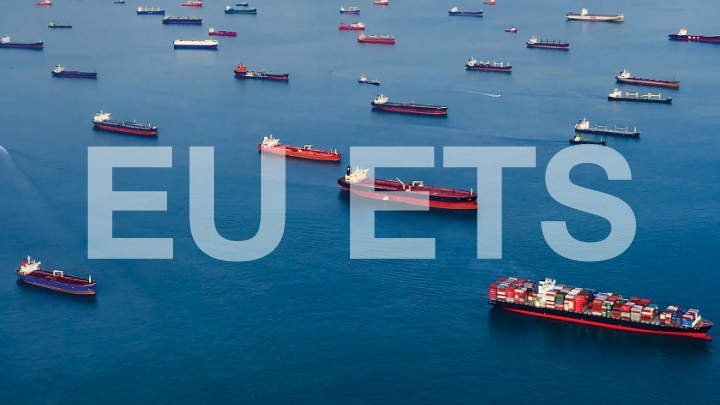
What is the EU Emission Trading System (EU ETS) maritime regulation?
The EU Emission Trading System (EU ETS) maritime regulation is an initiative aimed at addressing environmental concerns within the transport industry. This regulatory framework will be effective from 2025 and holds transport companies accountable for their emissions through the submission of EU Allowances (EUAs), as per Regulation (EU) 2015/757.
During a three-year phase-in period, companies gradually submit allowances: 40% in 2024, 70% in 2025, and 100% in 2026. This approach eases the transition for companies adapting to the regulatory requirements. In international trading involving an EU port, only 50% of emissions are considered. However, for trading within the EU, 100% of emissions are accounted for in the EUA.
In summary, the EU ETS regulation is a key driver in shaping eco-friendly practices for shipping companies, aligning with the EU's broader environmental goals.
What is the FuelEU maritime initiative?
The EU Fuel regulation, part of the FuelEU Maritime initiative, is a new law adopted by the EU to decrease the carbon intensity of fuels used in the maritime sector. It sets out specific targets for reducing greenhouse gas emissions, promotes the use of renewable and low-carbon fuels, mandates the use of on-shore power supply by ships docked in major EU ports, and establishes penalties and incentives to enforce compliance. This regulation aligns with the EU's broader climate goals under the Fit for 55 package and the European Climate Law.
What is the impact on your business?
The new EU Fuel regulation represents a significant shift towards sustainable practices. This regulation will require your business to adopt renewable and low-carbon fuel options, which may necessitate investments in new fuel technologies and infrastructural adjustments, particularly for on-shore power supply capabilities at major EU ports.
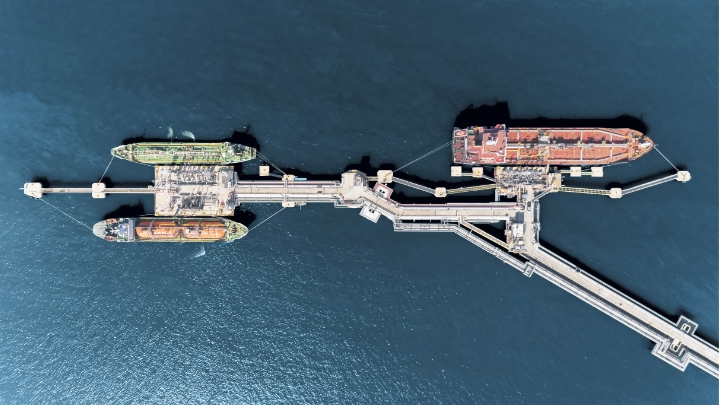
Navigate decarbonization of vessels in Service
Watch our ExpertTalk about how MAN´s cutting-edge solutions can support the improvement of your vessels´ current CII (Carbon Intensity Indicator) rating.
Key topics to explore:
- Latest news on CII regulations to understand the impact of CII requirements on your operations.
- Explore our two-strokes and four-strokes solutions to increase your vessel´s current rating.
- Discover powerful retrofit propulsion and propeller optimizations solutions.
- Learn about practical cases and actionable steps for decarbonizing your vessels.

